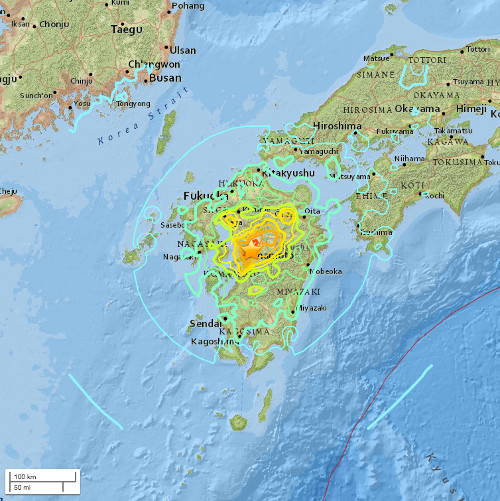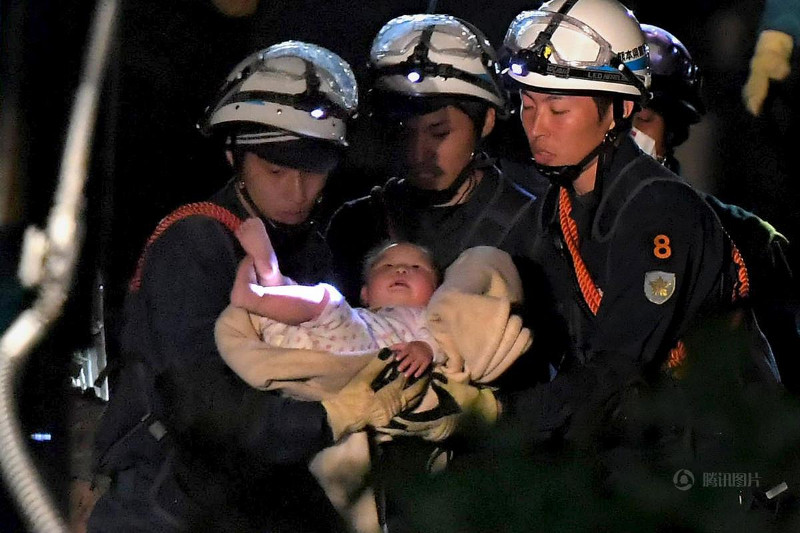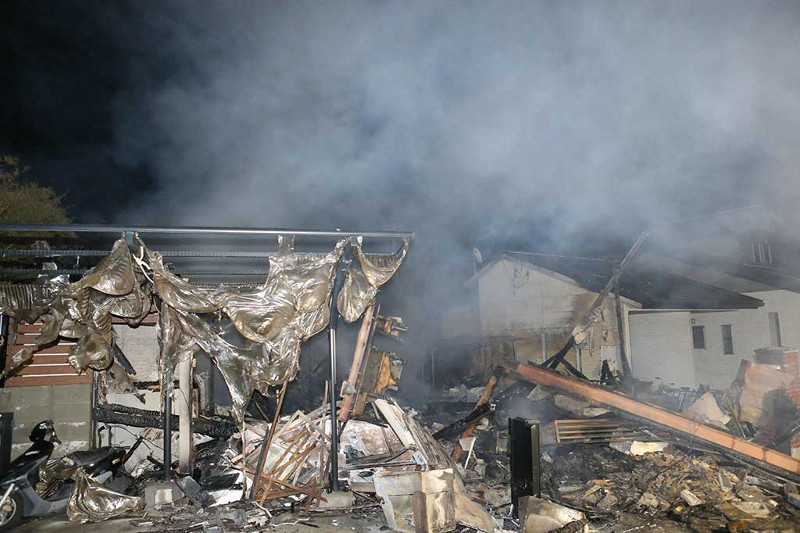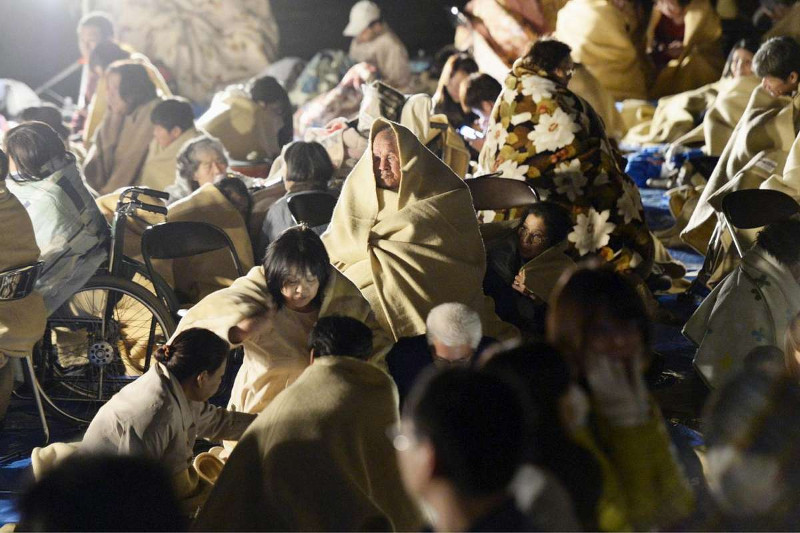Why does Japan have so many earthquakes?
A 7-magnitude earthquake rocked southern Japan, after less than 2 days a 6.2-magnitude earthquake also occurred in the region.
The most recent earthquake occurred in the city of Kumamoto, Kyushu island, Japan in the early morning of Saturday, April 16 at 1:25 am local time. Previously, the 6.2-magnitude earthquake occurred on Thursday 14 April. Until today, according to Reuters, earthquakes claimed 42 people, injured hundreds of others, many factories had to close down such as Toyota, Sony, Honda . There were about 30,000 rescues. Households are cleaning up ruins to find survivors and give food to people who cannot return to their families.

7 magnitude earthquake on Kumamoto, Kyushu island, Japan on April 16, 2016.(Photo: LiveScience).
Japanese Prime Minister Shinzo Abe told the National Assembly: "There are still many missing people. We are still making more efforts to save people and prioritize people's affairs." He also declared the disaster area to pave the way for disaster area reconstruction funding.
The Japan Atomic Agency has declared three nuclear plants in this area safe. These three plants met the nation's energy level that was affected by the Fukushima nuclear accident in 2011 due to earthquakes and tsunamis sweeping through the area. Meanwhile, commercial flights to the damaged Kumamoto airport were canceled and a Japanese military convoy arrived in the area also halted.
The food provided is limited due to landslide. Evacuees have sent SOS signals from a school yard, hoping that food supply helicopters will receive signals, Japanese media reported.
There have been more than 500 aftershocks since April 16, more than 70 matches are at level 4, according to the Japanese scale, strong enough to shake buildings.

An 8-month-old baby was rescued after her home collapsed due to an earthquake in Kumamoto's Mashiki town on April 16, 2016.(Photo: Reuters).
According to the Kumamoto area people escaping from these two great earthquakes and for many more days and with many memories of the magnificent 9.0-magnitude earthquake and tsunami sweeping Tohoku, Japan in 2011 still unremarkable among many Japanese people, the question is why does Japan suffer so many terrifying earthquakes?
Japan is located in what is known as the Pacific Ring of Fire , the most sensitive earthquake belt in the world. This "belt" is in fact an area shaped like a horseshoe that surrounds the Pacific Ocean, where many of the world's earthquakes and volcanic eruptions occur.
In this belt, many tectonic plates - including the Pacific tectonic plate at the bottom of the Pacific Ocean and the Philippines - merge and collide.
At the Pacific Ring of Fire, the movement and collision of the Pacific Plate and the Philippine Plate, tectonic plates at the bottom of the Pacific are the main causes of earthquakes.
"The surface of the earth is divided into several networks or there are many large segments moving around. When the plate tectonic shifting will collide with each other, things like earthquakes will happen" , Geologist Douglas Given of the US Geological Survey (USGS) in Pasadena, California.

Homes burned by earthquakes.
Today's earthquakes occur because the Philippine tectonic plate lies beneath the Eurasian tectonic plate colliding , according to geophysicist Paul Caruso.
"When tectonic plates move and collide with each other, at the boundary between them will create mountains or volcanoes, as well as create earthquakes and other geological phenomena." According to USGS geophysicist Paul Caruso, recent earthquakes are mostly due to collisions between the Philippines and Asia - Europe.
While Japan is no stranger to earthquakes, the 7.0-magnitude earthquake is one of the largest earthquakes in this southern region of Japan, Caruso for Live Science.
"The second largest earthquake may be the 6.7 magnitude earthquake that occurred on March 20, 1939 in this area. There were also magnitude 6.5 and 6.3 earthquakes but this is The largest earthquake was measured in this area, " Caruso added.
There has been a recommendation about a tsunami possibility that was broadcast after the April 16 earthquake, but was lifted immediately by the Japanese Meteorological Agency and no further warnings have been issued.
Not all earthquakes start causing tsunamis. In general, there are three factors that can create a serious earthquake-tsunami combination. The first is an earthquake of at least 7 magnitude. The second is that the epicenter of the earthquake must be deep in the ocean and finally the earthquake must be an earthquake.

Residents foot outside a working building in Mashiki, Kumamoto.(Photos: Getty Images, Kyodo / Reuters).
"We often have earthquakes around Fiji, but about 400 miles (640 km) deep in the ocean floor, so they can't form a tsunami. The April 16 earthquake is an earthquake - about 10km deep - but the epicenter of the earthquake is on the ground , meaning there will be no dangerous tsunamis , " Caruso said.
Given that there have not been many dangerous reports yet, USGS scientists and scientists will monitor the area to warn of potentially dangerous aftershocks. These aftershocks usually occur after a series of earthquakes and often decrease in size.
"This is quite a clear result and there are many other major aftershocks. And of course, after a big earthquake, structures will often weaken. The possibility of further threats is likely , " Given said Live Science knows.
People in this area may experience more shocks in the coming days."We can be sure that there will be more aftershocks. It is impossible to tell when and how big it is. No one can predict , " Caruso said.
- Earthquake in Japan and Ecuador involves
- Japan expects 320,000 people to die if they encounter strong earthquakes
- Japan has the risk of picking up earthquakes of 8 Richter scale
- Japan shakes by a 7.3-degree earthquake, with tsunamis
- Earthquakes in Japan make the day shorter
- Two earthquakes repeatedly shook southwestern Japan
- Japan created 'super product' of earthquake specialties
- Earthquakes were continuous in Japan and the Philippines
- The magnitude 6 earthquake shook Japan
- 30 earthquakes shook the island of Japan
- Earthquake shook Japan, causing tsunami warnings
- Japanese earthquake made land very serious
 Is the magnetic North Pole shift dangerous to humanity?
Is the magnetic North Pole shift dangerous to humanity? Washington legalizes the recycling of human bodies into fertilizer
Washington legalizes the recycling of human bodies into fertilizer Lightning stone - the mysterious guest
Lightning stone - the mysterious guest Stunned by the mysterious sunset, strange appearance
Stunned by the mysterious sunset, strange appearance